Message from the director of the Western and Central Africa Division
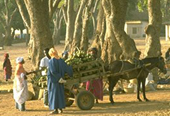 Africa has demonstrated that it has the potential to increase agricultural production, to feed its people and to market exports that bring in valuable foreign exchange revenues. Cassava production has quadrupled over the past ten years. Under favourable climatic conditions, millet and sorghum have recorded bumper harvests in recent years in the Sahel. Similarly, cocoa production has also grown. Yet these success stories often turn into failures because producers do not have ready access to markets and subsequently reduce or stop their production.
Africa has demonstrated that it has the potential to increase agricultural production, to feed its people and to market exports that bring in valuable foreign exchange revenues. Cassava production has quadrupled over the past ten years. Under favourable climatic conditions, millet and sorghum have recorded bumper harvests in recent years in the Sahel. Similarly, cocoa production has also grown. Yet these success stories often turn into failures because producers do not have ready access to markets and subsequently reduce or stop their production.
Ten years ago, most agricultural supplies and marketing were controlled by government boards. Individual farmers depended largely on them. But with the adjustment reforms of the 1990s, the role of these boards has become limited, where they have not been eliminated altogether. Many farmers have found themselves facing new environments and markets increasingly open to international competition.
Africa’s population is booming – by 2050, the population is expected to more than double from 906 million in 2005 to over 1,900 million. Yet too many African farmers are not able to take full advantage of the economic opportunities offered by local and regional markets. Studies by the United Nations Economic Commission for Africa indicate that the continent imports between US$15 to 20 billion of food items every year.
Furthermore, there is a huge potential market for smallholder farmers emerging in Africa’s cities. Africa is the most rapidly urbanizing continent, with annual urban growth of 4.5 per cent. By 2030, more than 50 per cent of the people in Africa will be living in urban areas. Feeding the cities is therefore a massive market that African farmers must explore and respond to.
Overall production levels have to improve. It can happen through the supply of seeds and fertilizers and the use of new technologies. Appropriate agricultural policies have to be implemented and the right incentives offered. Some farmers have already risen to the challenge, but many still struggle with difficult physical access to markets, and lack of market information and organizations to defend their interests.
To enable small farmers to effectively respond to this new demand,market analysis is needed and smallholder production patterns, processing and packaging need to adapt to fit into local, national and regional value chains.
At IFAD, we believe that to develop commodity chains, partnerships between producers’ organizations and larger-scale private enterprises need to be promoted. Involving the final buyer in the establishment of a commodity chain together with the small farmer will be to everyone’s benefit. We already have some success stories in the region with the initiative for organic cocoa in Sao Tome and Principe and the Market-Driven Initiative for Millet and Sorghum Development in West and Central Africa.
Our key task is to stimulate small farmers’ capacity to be effective commercial farmers benefiting fully from the value-added gained through marketing their produce. This can be achieved. But most of these farmers will need support. Building roads, assisting with contract brokerage and improving their understanding of market information will improve their access to efficient markets, thus increasing rural incomes. In this regard, there are many successful innovative experiences to replicate from one region to another, from one country to another. It is important that those lessons are shared. For that reason, IFAD’s Western and Central Africa Division intends to organize, in 2007, an innovation fair in the region with some key partners.
Today, we are working with governments to improve their national agriculture and rural development policies and institutional frameworks to enhance investment and equitable commercial relations for small farmers, and to establish the conditions required at the local, national and regional levels for farmers to operate in a sustainable manner. Please join us in this endeavour.
Mohamed Béavogui
Stories from the field
Cameroon: setting up farmers' field schools for cassava producers
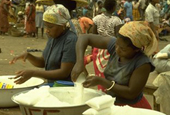 With public demand for cassava rising rapidly in Cameroon, new field schools to improve farmer productivity have been set up across the country over the past two years by the Roots and Tubers Market-Driven Development Programme (PNDRT).
With public demand for cassava rising rapidly in Cameroon, new field schools to improve farmer productivity have been set up across the country over the past two years by the Roots and Tubers Market-Driven Development Programme (PNDRT).
Over 300 farmers were trained in 2005 to use a new technology package that helps to increase production and protect crops.
“The programme has been so successful that we have doubled the number of schools’ fields to 20 this year,” says Andre Mbairanodji, the officer in charge of production and processing for the PNDRT.
The field schools are organized in the same villages where the farmers who are being trained live. Usually two parcels of land are cultivated next to each other: one according to the farmers’ traditional knowledge and the other using new technologies introduced by the schools.
“The trainees are shown different ploughing techniques and are made aware of soil conservation issues that are crucial in the case of cassava as it is known to impoverish soils,” says Mbairanodji. “They are also trained on how to fight against pests, using biological means such as ‘useful’ insects against ‘bad’ insects attacking the crops. They are also told about the use of chemicals in the production of cassava in case the above methods to fight against predators are not efficient. All this is done using better varieties of cassava that are healthier and more productive.”
The fields are visited every month so the farmers can see for themselves how differently both sets of crops are growing. They can see the way the leaves have grown, or whether diseases are developing. At the end of the training, the production from both parcels of land is weighed and their productivity compared.
About 80 per cent of the trainees are women as the production of roots and tubers is traditionally their domain. Men are also involved in the training’s harder work, such as uprooting tree stumps or building hillocks. “Our target is to double the national cassava production in the near future,” says Mbairanodji. “But we are also planning to focus on other crops such as yam, potatoes and sweet potatoes.”
The trainees have also been introduced to marketing techniques to make sure that they will be able to sell their soon-to-be-increased production. The main aim is to facilitate the exchange of information along the market chain.
“Sometimes farmers don’t know what to do with their harvest when just a few kilometres away there are buyers looking for crops and vice versa,” says Mbairanodji. “Surely these people can start talking to each other.”
For more information, please contact:
Abdoul Wahab Barry, Country programme manager
Thomas Ngue Bissa, Programme coordinator
André Mbairanodji, officer in charge of production and processing for the PNDRT
Useful links:
Congo: rebuilding the breadbasket after the conflict
 IFAD’s latest programme in the Congo is set to start in December 2006 around the town of Dolisie in the south-west. During the civil wars in the 1990s the region was the scene of widespread destruction.
IFAD’s latest programme in the Congo is set to start in December 2006 around the town of Dolisie in the south-west. During the civil wars in the 1990s the region was the scene of widespread destruction.
Agricultural production capacities were ruined. Three quarters of the livestock had either been killed or looted. There had been massive movements of civilians fleeing to the capital, Brazzaville, and to Pointe Noire, the main port on the Atlantic coast.
“The Nyari, Lekoumou and Bouenza departments were the breadbasket of the populated south before the conflict started,” says Luyaku Nsimpasi, IFAD’s country programme manager for the Congo.
Most donors in the country have concentrated on the emergency and relief aspects. IFAD’s focus is on the revival of production capacity. The priorities are to give the rural population access to drinkable water and to improved seeds and cuttings for main food crops such as cassava. The Rural Development Project in the Nyari, Bouenza and Lékoumou Departments will also focus on market access, with the building and maintenance of feeder roads.
The main challenge to working in a post-conflict situation has been addressing the lack of formal institutions in the programme area.
“That has been a major obstacle,” says Nsimpasi. “A programme must have the support of local institutions. When they have all but disappeared or are in disrepair, in a post-conflict situation, we have to rely on farmers’ organizations, local communities, NGOs, as the link between IFAD and the rural population.”
Nsimpasi says that he really hopes the programme can start as planned in December 2006, after the loan agreement was signed in May 2006. “The objective is that this southern region becomes again the thriving breadbasket it once was.”
For more information, please contact:
Luyaku Loko Nsimpasi, IFAD Country programme manager
Senegal: a new irrigation technique helps create jobs for young people
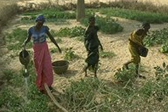 A new micro-irrigation technique tested along the Senegal River is providing poor farmers with higher yields and more diversified crops. The success of this technique has boosted not only production but also employment opportunities. Today, many young people sell the extra products in new stalls built alongside the fields and roads rather than look for work abroad.
A new micro-irrigation technique tested along the Senegal River is providing poor farmers with higher yields and more diversified crops. The success of this technique has boosted not only production but also employment opportunities. Today, many young people sell the extra products in new stalls built alongside the fields and roads rather than look for work abroad.
The rural families living in the area targeted by the Agricultural Development Project in Matam (PRODAM) have been depending on rainfed farming or extensive livestock activities for their livelihoods. But over the past few years, with rainfall averages reduced to 300 to 400 millilitres per year, their productivity has decreased drastically.
Thanks to micro-irrigation, farmers are now able to shift their production, at reasonable costs, from rice and cereals to market gardening. Watermelon, lettuce, carrot, potatoes, cabbage and onions are now available at local markets.
Having several harvests per year has improved both nutrition levels and incomes of the rural families involved in the project, says Mamadou Kane, IFAD’s field presence officer for Senegal and the Gambia. If the project keeps developing, there is the potential to start selling the crops to more distant markets in Dakar, 700 kilometres away.
Before PRODAM started, alternative commercial activities did not bring sufficient extra income to the local families.
“With very limited revenues and few job prospects, many families have been saving money to send the young men from the Matam area to try to build a new life in the capital Dakar,” says Kane. “Many have also attempted to make the perilous overseas journey to the European Union.”
The newly increased agricultural production could provide the opportunity to involve more youth in the local economy. As a direct consequence of the introduction of micro-irrigation, PRODAM is planning a pilot initiative that will set up kiosks near the fields to sell the crops. Additional kiosks will be set in and around suburban areas to sell some of the production.
“Local youth, who already have a basic education, could get a little training and run them with the help of a phone line to be in contact with potential buyers,” says Mamadou Thierno Bâ, PRODAM’s director. “It would be a real innovation in this country and would help farmers to keep their families together by involving their children. By selling directly off the field, and along the main roads in the area, it would also help producers to shave off the intermediaries who, too often, dictate the prices.”
For more information, please contact:
Sylvie Marzin, Country programme manager
Mamadou Thierno Bâ, Project director
Mamadou Kane, IFAD’s field presence officer for Senegal and the Gambia
Useful link:
Sao Tome and Principe: organic cocoa remains vibrant despite pest invasions
 Twenty farming communities on the island of Sao Tome cultivate organic cocoa exclusively for the export market. Their buyer is the French company KAOKA with whom they have signed a five-year contract in 2005 through the Cooperative for Export and Market of Organic Cocoa (CECAB). This experience has been incorporated into the Participatory Smallholder Agriculture and Artisanal Fisheries Development Programme (PAPAFPA)
Twenty farming communities on the island of Sao Tome cultivate organic cocoa exclusively for the export market. Their buyer is the French company KAOKA with whom they have signed a five-year contract in 2005 through the Cooperative for Export and Market of Organic Cocoa (CECAB). This experience has been incorporated into the Participatory Smallholder Agriculture and Artisanal Fisheries Development Programme (PAPAFPA)
Some 1,100 producers, of whom 42 per cent are women, are involved in the production of organic cocoa there. So far they are happy with the results as their revenues have been rising. Their challenge, though, is to increase their modest production. Since the operation started, the Sao Tome farmers have sold an average of 150 tons of dried beans per year to KAOKA. It is below the 400 tons expected by the French company – a level that would also allow the CECAB to make a profit.
To rise to the challenge before the end of the contract, farmers need to sort out irrigation problems and plant more cocoa trees to increase their density per hectare. They also have to fight diseases attacking the trees and pests destroying the harvest, and do so in an environmentally friendly way that will allow them to keep the certification to international organic standards. Some techniques have already been tested with positive results. Farmers are using lime sulphate to prevent diseases from developing. Insects known locally as robocintos, usually drawn to warm leaves, can be kept away by planting large trees to create enough shade to keep a cooler environment in the cocoa plantations.
Rodents continue to be a problem. Restricted to the use of non-chemical products, cocoa farmers have tried various techniques to get rid of them. But successive anti-rodent recipes, based on cement, grated maize or banana mixed with pieces of broken glass, have all failed. André Deberdt, CEO of KAOKA, suggested to the Sao Tome farmers that they try a traditional technique, already proven in Latin America, called “sugar bread”: a mixture of sugar and baking yeast that is deadly when eaten by the rodents. Small bags are prepared and suspended in the cocoa trees, between the leaves. To have any impact, the technique has to be implemented by all the farmers within a community and the bags set in all the parcels at the same time. The experiment in Sao Tome has already had some positive results. Farmers are able to increase their production, while preserving the precious organic certification of their cocoa.For more information, please contact:
Norman Messer, Country programme manager
Helder Pinto, Project coordinator, PAPAFPA
Antonio Alvaro da Graça, Head of the PAPAFPA’s bio cocoa chain
News
IFAD Executive Board approves US$46.29 million in loans and grants for Western and Central Africa
 The 88th session of IFAD’s Executive Board (13-14 September 2006) has approved new loans to support rural development programmes and projects and improve livelihoods in the Gambia, Nigeria and Senegal. The Board also approved grants under IFAD’s global and regional grants window to increase productivity and food security, boost natural resource management, extend rural financial services, control pests and disease, and support smallholder farmers, rural women and microfinance enterprises in the region.
The 88th session of IFAD’s Executive Board (13-14 September 2006) has approved new loans to support rural development programmes and projects and improve livelihoods in the Gambia, Nigeria and Senegal. The Board also approved grants under IFAD’s global and regional grants window to increase productivity and food security, boost natural resource management, extend rural financial services, control pests and disease, and support smallholder farmers, rural women and microfinance enterprises in the region.
Gambia: delivering financial services to poor rural people
The US$8.7 million Rural Finance Project in the Republic of the Gambia will be financed, in part, by a US$6.1 million loan and a US$400,000 grant from IFAD, with the remainder provided by the Government of the Gambia and those participating in the project’s activities. The project will provide to 180,000 participants, over half of whom are women, a broad range of carefully targeted supports to strengthen and consolidate the ability of existing microfinance institutions to deliver financial services to economically active poor rural people. An apex body will be established to support village savings and credit associations, and provide funds for training at all levels, including ordinary members and members of management committees.
Nigeria: building rural financial institutions
A US$27.2 million loan and a US$400,000 grant from IFAD will help finance the US$40.0 million Rural Finance Institution-Building Programme in Nigeria. The Government of Nigeria will contribute US$6.2 million, with US$4.8 million provided by other participating institutions. The Ford Foundation is expected to provide US$500,000 and the participants US$985,100. The programme will strengthen microfinance institutions and establish links among them and formal financial institutions in 12 states of Nigeria, in an effort to create a viable and sustainable rural financial system that reaches poor rural people. It will expand and improve productivity in agriculture and rural micro- and small enterprises, and reduce rural poverty, particularly among women, youth and the physically challenged. An estimated 345,000 families will benefit directly, of which at least 138,000 will be households headed by women.
Senegal: supporting agricultural services and producer organizations
The Agricultural Services and Producer Organizations Project – Phase II in Senegal will be partially funded by a US$6.0 million loan and a US$300,000 grant from IFAD. The four-year project is worth a total of US$47.0, including US$20.7 million from the Government of Senegal and US$20.0 million cofinancing from the World Bank. The project, as the second phase of a planned three phase programme, aims to reduce poverty in rural areas of Senegal by improving access by smallholder farmers to sustainable and diversified agricultural services and innovations. Diversifying and stabilizing agricultural production, increasing incomes of smallholder farmers and improving household food security are also key objectives. The project will strengthen the institutional framework put in place during the first phase, expand the coverage of agricultural advisory services nationwide, support the emergence of private service providers, strengthen research capacity, and focus and empower producer organizations, while increasing their social accountability and representation.
A US$1.5 million grant to the World Agroforestry Centre (ICRAF)
The new grant will fund, in part, the US$2.7 million Programme to Support Smallholder Conservation Agriculture Promotion in Western and Central Africa. The centre is supported by the Consultative Group on International Agricultural Research (CGIAR). The four-year programme will help reduce rural poverty in Western and Central Africa by improving poor rural people’s access to technology and natural resources, including land and water. The programme will promote community and smallholder-driven natural resource management, knowledge-sharing, cropping and farming systems.
A US$1.3 million grant to the CGIAR-supported International Institute of Tropical Agriculture (IITA)
The grant will partially fund the US$2.6 million Programme for the Integrated Protection of Cassava from Emerging Pests and Diseases that Threaten Rural Livelihoods. The three-year programme will increase and sustain cassava productivity and improve the livelihoods of farmers by reducing crop losses due to pests and diseases in sub-Saharan Africa. The programme will develop, test and implement sustainable integrated pest management (IPM) technologies in collaboration with various partners in five sub-Saharan African countries: Benin, Cameroon, the Democratic Republic of the Congo, Guinea and the United Republic of Tanzania.
A US$800,000 grant to the Participatory Microfinance Group for Africa (PAMIGA)
The grant will help fund the five-year Programme for the Promotion of Participatory Microfinance in Africa. The programme will use an innovative approach to strengthen the decision-making role of poor rural people and contribute to their empowerment as users and user-owners of local financial institutions.
A US$1.3 million grant to Sasakawa-Global 2000
This grant will finance, in part, the four-year US$1.9 million Market-Driven Initiative for Millet and Sorghum Development in West and Central Africa – Phase II. Building upon the achievements and lessons of the first phase, the initiative will improve food security in the semi-arid zones of Western and Central Africa, stimulating the consumption of traditional cereals, in particular millet and sorghum, and raising incomes in the traditional cereal sector.
A US$990,000 grant to the United Nations Capital Development Fund (UNCDF)
The grant will help finance the three-year Programme for Building Inclusive Financial Sectors in Western and Central Africa (BIFSA). The grant will support collaboration of the UNCDF and IFAD in implementing IFAD’s rural finance strategy in Western and Central Africa from 2006 to 2009 and closer cooperation by the two institutions on the BIFSA programme. The programme will improve access by poor rural people in the region to appropriate and sustainable financial services.
For more information, please contact:
Karim Hussein, regional economist
Useful link:
World Congress on Communication for Development held 25-27 October 2006 in Rome, Italy
The first World Congress for Communication Development was held in Rome on 25-27 October 2006 and attended by hundreds of participants from around the world. FIDAction interviewed Mouhamed Drabo, who works on the Community-Based Rural Development Project (Phase II) in Burkina Faso.
FIDAction: “Communication for development”— how relevant is this concept in a country like Burkina Faso?
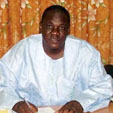 Mouhamed Drabo: The idea is growing in the country. Associations, networks and, generally, people involved in rural development are using the approach in their field activities. But there are clear divergences regarding the definition of the concept and its application. I can witness that directly among the members of the network of communicators in land management and local development that I have been leading for the past six years. It is important, in Burkina Faso in particular, that an in-depth analysis is done to decide how to make the concept work in our daily professional activity. It will help deciders and donors to understand properly the role of communication in the development process.
Mouhamed Drabo: The idea is growing in the country. Associations, networks and, generally, people involved in rural development are using the approach in their field activities. But there are clear divergences regarding the definition of the concept and its application. I can witness that directly among the members of the network of communicators in land management and local development that I have been leading for the past six years. It is important, in Burkina Faso in particular, that an in-depth analysis is done to decide how to make the concept work in our daily professional activity. It will help deciders and donors to understand properly the role of communication in the development process.
FIDAction: How should it work?
Mouhamed Drabo: It is about finding solutions together to the issues rural poor people face in their daily lives. It is about sharing, talking, arguing. And it can be done through many ways. Traditional chiefs and griots can be involved to respect the oral tradition. At the other end of the spectrum, Internet is also, obviously, becoming an essential tool. The crucial point is to get the information to flow, to travel. Partnerships could be set up between development projects and journalists to raise general awareness on development issues.
FIDAction: What will you take home from this congress?
Mouhamed Drabo: I had two objectives before coming here. First, I wanted to understand how this new concept of communication for development is being used around the world. And, I wanted to see what real impact it can have on the achievements of development projects.
I have noted that there is a collective understanding about the importance of communication amongst those involved in development, and particularly amongst decision-makers. There was also a general agreement that using the tool of communication should be a priority in our field.
But during the discussions, it felt that we should be very careful about the communication channels we are using. The communication techniques used in developed countries can sometimes be remote and virtually not understandable by a vast majority of the population, mostly illiterate, of a developing country. I think that this aspect was not discussed thoroughly during the congress.
FIDAction: What concrete influence can the debates of this congress have now in the field?
Mouhamed Drabo: The congress was successful in raising the fact that we need to invest in the communication dimension in development projects as soon as they start being designed. One of the recommendations of the congress is to give proper financing to the communication side of projects and to involve the population efficiently. The network I am heading will follow the recommendations that are similar to those we adopted during a regional workshop held in June with representatives from Benin, Burkina Faso, Mali, Niger and Senegal. Generally, I have been heartened by the congress results because we have convincing arguments to implement the action plan on communication of sustainable development.
For more information, please contact:
Mouhamed Drabo, Head of technical support service, PNGT-II
Events
IFAD President visits Cameroon
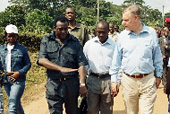 Following an official invitation from the President of the Republic of Cameroon, the President of the International Fund for Agricultural Development (IFAD), Lennart Båge, visited Cameroon from 27 November to 1 December.
Following an official invitation from the President of the Republic of Cameroon, the President of the International Fund for Agricultural Development (IFAD), Lennart Båge, visited Cameroon from 27 November to 1 December.
During his visit, Båge met with local participants of the Community Development Support Project in the village of Bikogo in Cameroon's Central Province. In the village, Båge visited a pig rearing and fattening project, fish ponds, a well and two classrooms. The project works in Cameroon's Far-North and Central Provinces to improve food security and rural incomes and empower local communities to lead their own development.
Båge also met with participants of the Roots and Tubers Market-driven Development Programme and the National Microfinance Programme Support Project. They hosted an exhibit in Bikogo to feature products from local microenterprises. Farmers talked with President Båge about how they cope with their conditions and the additional support they need to fight poverty.
With President Biya, cabinet members, key stakeholders and development partners, Båge discussed the important role that agriculture can play in economic growth and poverty reduction.
“Cameroon has many assets including peace and a strong agricultural base,” said Båge. “The focus has to be on development as a way to reinforce peace. Achieving these objectives will require investments in road infrastructure to connect smallholder farmers to markets.”
 Special attention was given to microfinance by the Cameroon leaders, prompting IFAD to focus on this issue in a new programme that is to be developed in Cameroon by the end of 2007.
Special attention was given to microfinance by the Cameroon leaders, prompting IFAD to focus on this issue in a new programme that is to be developed in Cameroon by the end of 2007.
As a sign of recognition and gratitude, the President of IFAD was granted a medal by the Prime Minister of Cameroon and was made Chief of the village Minkoa near Lobo by project participants.
Useful links:
FAO, IFAD and WFP Executive heads visit Ghana together to highlight field-level cooperation by Rome food-based agencies
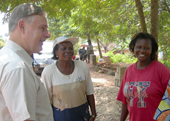 Lennart Båge, President of IFAD, Jacques Diouf, Director-General of FAO and James Morris, Executive Director of WFP demonstrated their determination to strengthen joint efforts to reduce hunger and poverty at the grassroots level visiting Ghana from 3 to 5 December.
Lennart Båge, President of IFAD, Jacques Diouf, Director-General of FAO and James Morris, Executive Director of WFP demonstrated their determination to strengthen joint efforts to reduce hunger and poverty at the grassroots level visiting Ghana from 3 to 5 December.
Ghana, with a population of 21 million people, is among the first countries in sub-Saharan Africa to have reached and even surpassed the 1996 World Food Summit goal of reducing by half the number of undernourished people by 2015. Between 1990-92 and 2001-2003, the number of hungry people fell from 5.8 to 2.4 million – a 59 per cent reduction. However, pockets of food insecurity remain in certain areas, including the northern region around Tamale, visited by the three UN leaders.
FAO, IFAD and WFP share the vision of building a food-secure country through a twin track approach: provision in the short term of assistance to hungry households to meet their education, health and nutrition needs and building medium and long term sustainable livelihoods through agricultural and rural development.
“Investing in agriculture and rural development can not only boost the standard of living for poor rural women, children and men, but can spur economic growth for an entire region,” said Båge.
A common strategic approach
Areas of collaboration by the three agencies include:
- supporting local development and governance, and also women’s groups
- providing support to the Ghana School Feeding Programme to improve nutrition and education using food produced locally by school and family gardens and smallholder farmers
- ensuring sustainable food production, in particular of cereals, roots and tubers that make a growing contribution to national food security
- improving agriculture and water related infrastructure for the development of small-scale irrigation and pro-poor rural enterprise
- promoting, through the International Alliance against Hunger, an initiative of the three Rome-based organizations and their partners, a Ghanaian National Alliance against Hunger to raise awareness about poverty reduction and food security by different groups including the media, the private sector, civil society, academic and local organizations
- IFAD operations in Ghana
- Rural poverty in Ghana
- Heads of FAO, IFAD and WFP work together to fight hunger and poverty in Ghana
- Joint press release: FAO, IFAD and WFP Executive heads in joint visit to Northern Ghana
Useful links:
